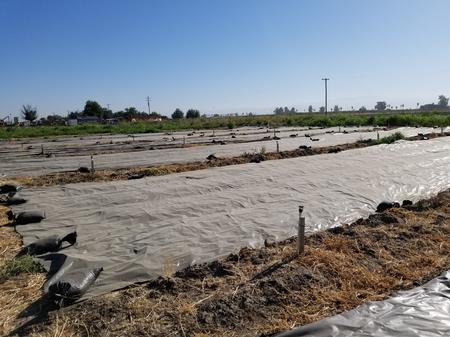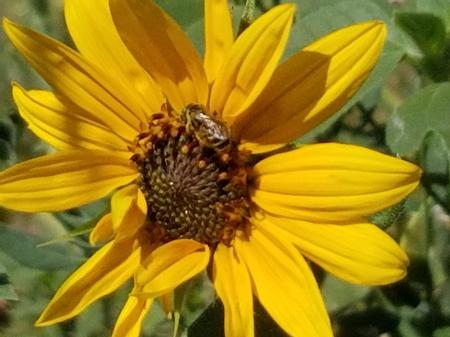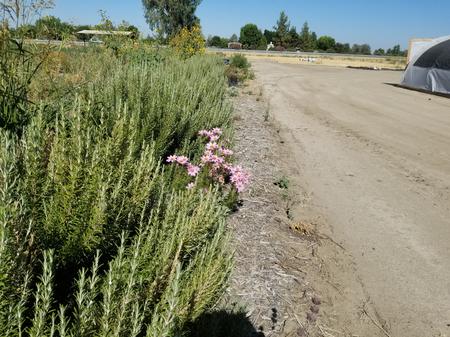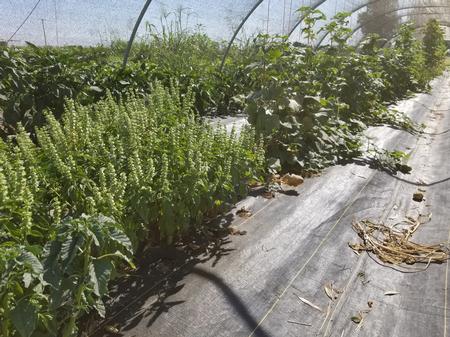Pickalittle Farm
Occultation, cover crops, compost, field borders, reduced tillage, companion planting, crop rotation
Mary Jean Russell runs Pickalittle Farm, a diversified vegetable operation in Bakersfield, CA. She provides organically-grown vegetables and herbs to local restaurants and to CSA members. She started growing food in 2000, on the 3 acres of land surrounding her house.
She started implementing conservation practices in 2004 to save money and labor. The goal is to promote a healthy soil that produces nutritious food while minimizing costs and labor. To that end, she’s developing a closed-loop system to reduce expensive external inputs. She’s even found that weeds encourage beneficial insect populations. She calls her cocktail of cover crops, compost, and animal manure a bone broth for the soil, since it adds nutrients and organic matter to keep the soil healthy.
Last year, she expanded her operations to a 14 acre parcel on the edge of town. She currently farms on about 4 acres of the new property.
Practices
The first climate smart practice Mary Jean implemented on her farm was spreading compost. She then stopped spraying herbicides and insecticides and reduced her tillage. Then she started planting cover crops.
Mary Jean puts down tarps to reduce her weed population without resorting to herbicides or intensive tillage. This process is called occultation.

Black plastic covers the ground for a couple weeks and kills the growing weeds. She then takes the tarps off and irrigates the plot to encourage more weed growth. Once the new weeds have sprouted, she covers the area with the tarp again to kill off the nascent weeds.
This process worked well in the plots where she’s already gone through the entire process and planted crops. The row of summer squash she planted enjoyed an almost weed-free plot – without any hand weeding, flaming, or tillage!
Mary Jean also ensures plant diversity throughout her farm. She plants annual herbs and flowers along her field borders. She also includes basil next to her peppers and tomatoes. She even allows weeds to flourish in parts of the farm where she doesn’t have crops growing. This wide diversity of plants encourages the proliferation of beneficial insects.
Effects
Yield effects
She started seeing increased yields at her first farm after about 1 year of compost applications and no sprays. The insects and soil started to balance out and she saw an increase in food quality.

Pest effects
Mary Jean has seen an increase in earthworms and other beneficial insects. The first year of not spraying insecticides at both her original farm and her new property saw huge swings in pest populations – a boom and bust cycle of pests like earwigs and flea beetles.
Erosion effects
She has found that dust devils that come onto the farm quickly die out because the weeds in the non-farmed areas, the cover crops, and the crops keep the soil covered. All these plants reduce the amount of dust that is available for the wind to pick up, so dust devils have to slow down and even stop when they get to her property.

Water consumption effects
She is working on reducing her water consumption and hopes that all the work that she is doing to increase the soil’s organic matter will increase the soil’s water holding capacity. Once her tomatoes start to fruit, she turns off the irrigation. This keeps the tomatoes from splitting and intensifies the flavors. She also has started planting cover crops like radish and sorghum to improve the soil’s infiltration rates.
Effects on overall profitability
She does not buy sprays and does not have to apply for a pesticide applicator license. This saves her both money and time, since she doesn’t have to deal with the paperwork or the continuing education credits she would need if she were farming conventionally. Plus she doesn’t have to buy the specialized equipment for spraying insecticides or herbicides. Instead, she spends about $2,000 per half acre plot every 18 months to reduce her weed pressure by doing occultation and cover crops. This cost is less than what she would spend if she were farming conventionally.

Recommendations
Mary Jean explained that there is a steep learning curve when implementing these practices. You have to understand the specific conditions of your field. Even the couple miles between the first garden and the new farm made a huge different in terms of pest and weed issues. At her new farm, Mary Jean learned the hard way not to put down any plastic tarps between November and April because the strong winter winds would destroy them.
She would recommend these practices to other growers, with some caveats. Plastic, after all, can pollute the soil and water and eventually ends up in the landfill. But for her, it’s better than spraying synthetic chemicals and she hopes that another year or two of occultation work will knock down the weed pressure to the point that she won’t have to use so much plastic in the future. She recommends that growers keep the occultation to a small scale.
For cover crops, she is still on the steep part of the learning curve, since there is so much to figure out: timing, termination, and species selection. She would recommend starting out with a dry-farmed winter cover crop.
She also advises growers to test their soil often and to create concrete, measurable short-term and long-term benchmarks and goals. She recommends reaching out to your local resources, including the extension office.
